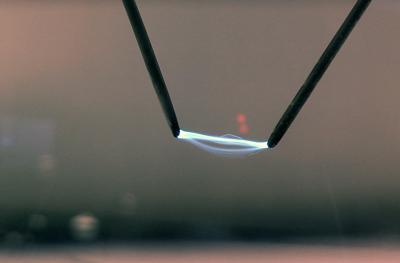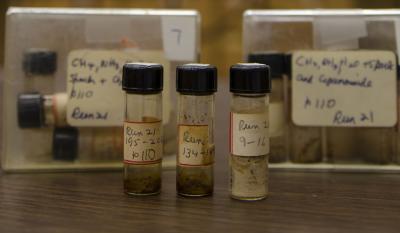An electric discharge experiment simulates early Earth conditions using relatively simple starting materials. The reaction is ignited by a spark, simulating lightning, which was likely very common on the early Earth.
The 1958 reaction samples were analyzed by Parker and his current mentor, Facundo M. Fernández, a professor in the School of Chemistry and Biochemistry at Georgia Tech. They conducted liquid chromatography- and mass spectrometry-based analyses and found that the reaction samples from 1958 contained peptides. Scientists from NASA's Johnson Space Center and Goddard Space Flight Center were also involved in the analysis.
The research team then set out to replicate the experiment. Parker designed a way to do the experiment using modern equipment and confirmed that the reaction created peptides.

A close-up of the spark that simulates the energy provided by lightning on the early Earth. Credit: Georgia Tech
"What we found were some of the same products of polymerization that we found in the original samples," Parker said. "This corroborated the data that we collected from analyzing the original samples."
In the experiment from 1958, Stanley Miller had the idea to use the organic compound cyanamide in the reaction. Scientists had previously thought that the reaction with cyanamide would work only in acidic conditions, which likely wasn't widely available on early Earth. The new study showed that reactive intermediates produced during the synthesis of amino acids enhanced peptide formation under the basic conditions associated with the spark discharge experiment.
"What we've done is shown that you don't need acid conditions; you just need to have the intermediates involved in amino acid synthesis there, which is very reasonable," Bada said.
Why Miller added cyanamide to the reaction will probably never be known. Bada can only speculate. In 1958, Miller was at Columbia University in New York City. Researchers at both Columbia and the close-by Rockefeller Institute were at the center of studies on how to analyze and make peptides and proteins in the lab, which had been demonstrated for the first time in 1953 - the same year that Miller published his famous origin of life paper.
Perhaps while having coffee with colleagues someone suggested that cyanamide – a chemical used in the production of pharmaceuticals – might have been available on the early Earth and might help make peptides if added to Miller's reaction.

Vials contain samples of prebiotic materials created by Stanley Miller in 1958, labeled by Miller himself. Miller added a potential prebiotic condensation agent, cyanamide, during the course of the experiment. Cyanamide has been suggested to induce polymerization of amino acid into simple peptides which is an important set in chemical evolution and possibly the origin of life. For unknown reasons, Miller had never analyzed the samples. In a paper published in 2014, researchers at Georgia Tech and Scripps Institution of Oceanography at UC San Diego analyzed the samples and established the potential importance of reagents - substances that cause chemical reactions such as cyanamide -- in the origin of life on Earth. Credit: Scripps Institution of Oceanography, UC San Diego.
"Everybody who would have been there and could verify this is gone, so we're just left to scratch our heads and say 'how'd he get this idea before anyone else,'" Bada said.
The latest study is part of an ongoing analysis of Stanley Miller's old experiments. In 2008, the research team found samples from 1953 that showed a much more efficient synthesis than Stanley published in Science in 1953.
In 2011, the researchers analyzed a 1958 experiment that used hydrogen sulfide as a gas in the electric discharge experiment. The reactions produced a more diverse array of amino acids that had been synthesized in Miller's famous 1953 study. Eric Parker was the lead author on the 2011 study.
"It's been an amazing opportunity to work with a piece of scientific history," Parker said.






Comments